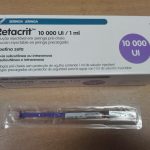Retacrit: Uses, How it Works, Dosage, Side Effects, Cost

What is Retacrit?
Retacrit is a ‘biosimilar’ medicine, a form of erythropoietin (a substance naturally made by the kidneys) that is made in the laboratory. Retacrit comes as a solution for injection. It is available in prefilled syringes containing between 1,000 and 40,000 international units (IU) of the active substance, epoetin zeta.
As the first approved epoetin alfa biosimilar in the U.S., Retacrit may provide patients and their physicians with increased access to a high-quality, lower-cost alternative treatment option for anemia and the reduction of allogeneic red blood cell (RBC) transfusions in certain patients
The FDA approval was based on a comprehensive data package submitted by Pfizer demonstrating a high degree of similarity between Retacrit and its U.S. reference product, Epogen and Procrit.
How does Retacrit work?
A hormone called erythropoietin stimulates the production of red blood cells from the bone marrow. Erythropoietin is produced by the kidneys. In patients receiving chemotherapy or with kidney problems, anemia can be caused by a lack of erythropoietin, or by the body not responding enough to the erythropoietin it has naturally. In these cases, erythropoietin is used to replace the missing hormone or to increase red-blood-cell counts. Erythropoietin is also used before surgery to increase the number of red blood cells to help patients produce more blood for self-donation.
The active substance in Retacrit, epoetin zeta, is a copy of human erythropoietin and works in exactly the same way as the natural hormone to stimulate red blood cell production. It is produced by a method known as ‘recombinant DNA technology: it is made by a cell that has received a gene (DNA), which makes it able to produce epoetin zeta.
What is Retacrit used for?
Retacrit is used in the following situations:
• to treat anemia (low red-blood-cell counts) that is causing symptoms in patients with chronic renal failure (long-term, progressive decrease in the ability of the kidneys to work properly) or other kidney problems;
• to treat anemia in adults receiving chemotherapy to treat certain types of cancer and to reduce the need for blood transfusions;
• to increase the amount of blood that patients with moderate anemia can self-donate before surgery so that their own blood can be given back to them during or after surgery.
• to reduce the need for blood transfusions in patients with moderate anemia about to undergo major bone surgery (such as a hip or knee replacement).
The medicine can only be obtained with a prescription.
How is Retacrit used?
Treatment with Retacrit must be started under the supervision of doctors who have experience in the management of patients with the conditions that the medicine is used for.
For patients with kidney problems, Retacrit can be injected into a vein or under the skin. For patients receiving chemotherapy, it must be injected under the skin, and for patients about to undergo surgery, it must be injected into a vein. The dose, the frequency of injection, and how long Retacrit is used depends on why it is being used, and are adjusted according to the patient’s response. For patients with chronic renal failure or receiving chemotherapy, hemoglobin levels should remain within the recommended range (between 10 and 12 grams per decilitre in adults and between 9.5 and 11 g/dl in children). Hemoglobin is the protein in red blood cells that carries oxygen around the body. The lowest dose that provides adequate control of symptoms should be used.
The iron levels of all patients should be checked before treatment to make sure that they are not too low, and iron supplements should be used throughout treatment. Retacrit can be injected under the skin by the patient or their carer if they have been trained appropriately. For full details, see the package leaflet.
What benefit has Retacrit shown during the studies?
Retacrit was as effective as Eprex / Erypo in correcting and maintaining red blood cell counts. In the correction study, hemoglobin levels were around 11.6 g/dl during the last four weeks of the study, having risen from around 8.0 g/dl before treatment. In the study of patients already being treated with an epoetin, hemoglobin levels were maintained at around 11.4 g/dl when the patients were receiving Retacrit and when they were receiving Eprex / Erypo. In both studies, the dose of epoetin received was similar to both medicines.
Retacrit was also effective when it was injected under the skin. The study in patients receiving chemotherapy showed that Retacrit brought about similar improvements in hemoglobin levels as those reported in the scientific literature for other epoetins. Retacrit was also as effective as the reference medicine in patients with kidney problems.
What are the risks and side effects associated with using Retacrit?
As with other medicines containing epoetin, the most common side effect with Retacrit is an increase in blood pressure, which can sometimes lead to symptoms of encephalopathy (brain problems) such as sudden stabbing migraine-like headache and confusion. Retacrit can also lead to skin rash and influenza (flu)-like symptoms. For the full list of all side effects reported with Retacrit, see the package leaflet.
Retacrit should not be used in people who may be hypersensitive (allergic) to epoetin zeta or any of the other ingredients. It must not be used in patients who have developed pure red-cell aplasia (reduced or stopped red-blood-cell production) following treatment with any erythropoietin, patients with hypertension (high blood pressure) that is not controlled, patients about to undergo surgery who have severe cardiovascular (heart and blood vessel) problems including a recent heart attack or stroke, or patients who cannot receive medicines to prevent blood clots.
Retacrit must not be used prior to major bone surgery in patients who have a severe disease affecting their arteries or their blood vessels in the heart, neck, or brain, including patients who have recently had a heart attack or stroke.
Common side effects of Retacrit include:
• blood clots and deep vein thrombosis DVTs,
• bone pain,
• chills
• cough,
• depression,
• difficulty swallowing,
• dizziness,
• fever,
• headache,
• high blood pressure (hypertension),
• high blood sugar (hyperglycemia),
• injection site irritation or pain,
• insomnia,
• itching, and
• joint pain,
• low blood potassium,
• low white blood cell count (leukopenia),
• medical device malfunction, blockage of a blood vessel,
• muscle spasm or pain,
• nausea,
• rash,
• swelling and sores inside the mouth,
• upper respiratory tract infection,
• vomiting,
• weight loss,
This is not a complete list of side effects and others may occur. Call your doctor for medical advice about side effects. You may report side effects to FDA at 1-800-FDA-1088.
How much does a shot of Retacrit cost?
The average cost of Retacrit 1 Vial, 1ml of 10000unit/ml each, is $134.36 depending on the pharmacy you visit. This is a brand-name drug and a generic may be available.





